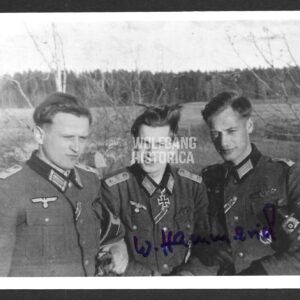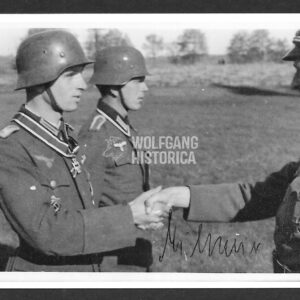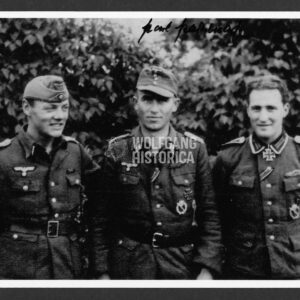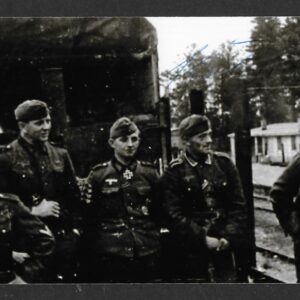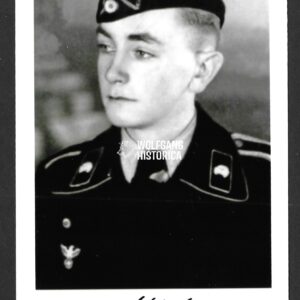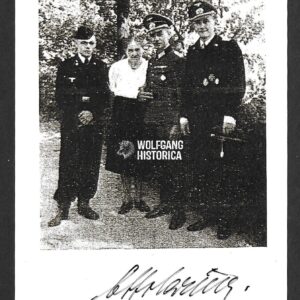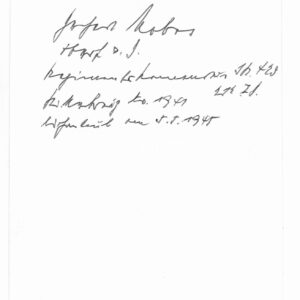Sign in
Login
Register
Willi Hammerich – Grenadier-Regiment 956 (362. Infanterie-Division)
€25,00
Original Postwar Signature on a Postwar Photo of Willi Hammerich. Oberleutnant Willi Hammerich (17.12.1921 in Fleckeby † 21.11.2010 in Schulensee) earned the Ritterkreuz des Eisernen Kreuzes on December 9, 1944 as Oberleutnant und Chef of the 4. Kompanie/ Grenadier-Regiment 956 of the 362. Infanterie-Division. Condition as seen. Postcardsize.
Add to Cart
Add to Compare
Johannes Eikmeier – Reiter-Regiment 32 (3. Kavallerie-Brigade)
€20,00
Original Postwar Signature on a Postwar Photo of Johannes “Hans” Eikmeier. Major Johannes Eikmeier (03.12.1918 † 05.09.2012) earned the Deutsches Kreuz in Gold on January 25, 1943 as Oberleutnant in the Aufklärungs-Abteilung 120 and the Ritterkreuz des Eisernen Kreuzes on September 30, 1944 as Rittmeiter und Führer with II. Bataillon/ Reiter-Regiment 32 of the 3. Kavallerie-Brigade. Good condition. Postcardsize.
Add to Cart
Add to Compare
Norbert Kujacinski – Panzer-Regiment 23 (23. Panzer-Division)
€25,00
Original Postwar Signature on a Postwar Photo of Norbert Kujacinski. Hauptmann Norbert Kujacinski (11.07.1920 † 02.05.2009) earned the Deutsches Kreuz in Gold and the Ritterkreuz des Eisernen Kreuzes on November 18, 1944 with Panzer-Regiment 23 of the 23. Panzer-Division. He also earned the Panzerkampfabzeichen IV. Stufe (Einsatzahl “75”). Condition as seen. Postcardsize.
Add to Cart
Add to Compare
Norbert Kujacinski – Panzer-Regiment 23 (23. Panzer-Division)
€25,00
Original Postwar Signature on a Postwar Photo of Norbert Kujacinski. Hauptmann Norbert Kujacinski (11.07.1920 † 02.05.2009) earned the Deutsches Kreuz in Gold and the Ritterkreuz des Eisernen Kreuzes on November 18, 1944 with Panzer-Regiment 23 of the 23. Panzer-Division. He also earned the Panzerkampfabzeichen IV. Stufe (Einsatzahl “75”). Condition as seen. Postcardsize.
Add to Cart
Add to Compare
Norbert Kujacinski – Panzer-Regiment 23 (23. Panzer-Division)
€25,00
Original Postwar Signature on a Postwar Photo of Norbert Kujacinski. Hauptmann Norbert Kujacinski (11.07.1920 † 02.05.2009) earned the Deutsches Kreuz in Gold and the Ritterkreuz des Eisernen Kreuzes on November 18, 1944 with Panzer-Regiment 23 of the 23. Panzer-Division. He also earned the Panzerkampfabzeichen IV. Stufe (Einsatzahl “75”). Condition as seen. Postcardsize.
Add to Cart
Add to Compare
Karl Radermacher – Grenadier-Regiment 45 (RK + NKIG!) (A5-Size)
€35,00
Original Postwar Signature on a Postwar Photo of Karl Radermacher. Leutnant Karl Radermacher (12.12.1922 † 09.10.2016) earned the Deutsches Kreuz in Gold on November 27, 1944, the Ritterkreuz on May 4, 1944 as Gefreiter und Granatwerfer-Truppführer in the 6. Kompanie/ Grenadier-Regiment 45 of the 21. Infanterie-Division and the Nahkampfspange in Gold on October 21, 1944. Good condition. Large A5 size.
Knight’s Cross: “In early 1944 the Soviets launched an attack that broke through the frontline of Grenadier-Regiment 45, and shortly afterwards they engaged the flank of the Regiment’s II. Bataillon in bitter close combat. After all the officers and NCOs had become casualties, Radermacher took charge of the situation and independently decided to meet the Soviet onslaught with his mortars, as all other attempts at success had failed. Constantly moving his guns to suitable positions, he was able to direct precise and deadly fire into the ranks of the attackers, inflicting high losses. Radermacher then led a counterattack once he judged the time to be right and was able to retake the old German line. In recognition of this success he was decorated with the Knight’s Cross.”
Add to Cart
Add to Compare
The Nahkampfspange was presented to him by Reichsführer-SS Heinrich Himmler personally in the town hall of Ulm on December 12th, 1944.
August Kaminski – schwere Panzerjäger-Abteilung 655
€20,00
Original Postwar Signature on a Postwar Photo of August Kaminski. Oberfeldwebel August Kaminski (09.08.1915 in Mertenheim-Lötzen † 15.08.2012 in Heyerode) earned the Deutsches Kreuz in Gold on October 10, 1943 as Oberfeldwebel with the schwere Panzerjäger-Abteilung 655 and the Ritterkreuz des Eisernen Kreuzes on October 6, 1944 as Oberfeldwebel und Zugführer in the 3. Kompanie/ schwere Panzerjäger-Abteilung 655. Postcardsize. Condition as seen.
Add to Cart
Add to Compare
Franz Bayer – Panzer-Regiment 26 (26. Panzer-Division)
€30,00
Original Postwar Signature on a Postwar Photo of Franz Bayer. Hauptmann Franz Bayer (03.02.1920 in Langau † 28.04.204 in Wien) earned the Deutsches Kreuz in Gold on October 7, 1942 with Panzer-Regiment 39 and the Ritterkreuz des Eisernen Kreuzes on May, 1945 as Hauptmann und Kommandeur of the I. Abteilung/ Panzer-Regiment 26 of the 26. Panzer-Division. He also earned the Panzerkampfabzeichen III. Stufe ("50") with Panzer-Regiment "Großdeutschland". Condition as seen.
Add to Cart
Add to Compare
Franz Bayer – Panzer-Regiment 26 (26. Panzer-Division)
€30,00
Original Postwar Signature on a Postwar Photo of Franz Bayer. Hauptmann Franz Bayer (03.02.1920 in Langau † 28.04.204 in Wien) earned the Deutsches Kreuz in Gold on October 7, 1942 with Panzer-Regiment 39 and the Ritterkreuz des Eisernen Kreuzes on May, 1945 as Hauptmann und Kommandeur of the I. Abteilung/ Panzer-Regiment 26 of the 26. Panzer-Division. He also earned the Panzerkampfabzeichen III. Stufe ("50") with Panzer-Regiment "Großdeutschland". Condition as seen. Postcardsize.
Add to Cart
Add to Compare
Ludwig Bauer – Panzer-Regiment 33 (9. Panzer-Division) (A5-Size)
€20,00
Original Postwar Signature on a Postwar Photo of Ludwig Bauer. Leutnant Ludwig Bauer (16.02.1923 † 20.05.2020) earned the Ritterkreuz des Eisernen Kreuzes on April 29, 1945 as Leutnant und Führer in the 1. Kompanie/ Panzer-Regiment 33 “Prinz Eugen” of the 9. Panzer-Division. Good condition. Large A5 size.
Read more
Add to Compare
Klaus Feldt – Schnellboot “S-30” & 2. Schnellbootflottille (Eichenlaub)
€35,00
Original Postwar Signature on a Postwar Photo of Klaus Feldt. Korvettenkapitän Klaus Feldt (14.04.1912 † 07.09.2010) earned the Ritterkreuz des Eisernen Kreuzes on June 13, 1942 as Oberleutnant zur See und Kommandant of Schnellboot “S-30” and the Eichenlaub on January 1, 1944 as Korvettenkapitän und Chef of the 2. Schnellbootflottille. Postcardsize.
Add to Cart
Add to Compare
Klaus Feldt – Schnellboot “S-30” & 2. Schnellbootflottille (Eichenlaub)
€35,00
Original Postwar Signature on a Postwar Photo of Klaus Feldt. Korvettenkapitän Klaus Feldt (14.04.1912 † 07.09.2010) earned the Ritterkreuz des Eisernen Kreuzes on June 13, 1942 as Oberleutnant zur See und Kommandant of Schnellboot “S-30” and the Eichenlaub on January 1, 1944 as Korvettenkapitän und Chef of the 2. Schnellbootflottille. Postcardsize.
Add to Cart
Add to Compare
Walter Fasel – Füsilier-Regiment 26 (30. Infanterie-Division)
€25,00
Original Postwar Signature on a Postwar Photo of Walter Fasel. Feldwebel Walter Fasel (07.06.1919 † 13.08.2013) earned the Ritterkreuz des Eisernen Kreuzes on August 31, 1943 as Feldwebel und Zugführer of the 14. Kompanie/ Füsilier-Regiment 26 of the 30. Infanterie-Division. Good condition. Postcardsize.
Add to Cart
Add to Compare
Wilhelm Salz – Grenadier-Regiment 502 (290. Infanterie-Division)
€25,00
Original Postwar Signature on a Postwar Photo of Wilhelm "Willi" Salz. Leutnant Wilhelm Salz (14.09.1915 in Duisburg † 30.01.2011 in Duisburg) earned the Ritterkreuz des Eisernen Kreuzes on September 10, 1944 as Leutnant und Führer of the 6. Kompanie/ Grenadier-Regiment 502 of the 290. Infanterie-Division. Good condition. Postcardsize.
Add to Cart
Add to Compare
Hermann Kunz – Panzerjäger-Abteilung 37 (1. Panzer-Division)
€20,00
Original Postwar Signature on a Postwar Photo of Hermann Kunz. Leutnant Hermann Kunz (12.12.1919 in Augsburg † 18.03.2012 in Augsburg) earned the Deutsches Kreuz in Gold on February 11, 1943 and the Ritterkreuz des Eisernen Kreuzes on December 17, 1943 as Leutnant und Zugführer in the 2. Kompanie/ Panzerjäger-Abteilung 37 of the 1. Panzer-Division. Good condition. Postcardsize.
Add to Cart
Add to Compare
Karl Radermacher – Grenadier-Regiment 45 (RK + NKIG!)
€35,00
Original Postwar Signature on a Postwar Photo of Karl Radermacher. Leutnant Karl Radermacher (12.12.1922 † 09.10.2016) earned the Deutsches Kreuz in Gold on November 27, 1944, the Ritterkreuz on May 4, 1944 as Gefreiter und Granatwerfer-Truppführer in the 6. Kompanie/ Grenadier-Regiment 45 of the 21. Infanterie-Division and the Nahkampfspange in Gold on October 21, 1944. Good condition. Postcardsize.
Knight’s Cross: “In early 1944 the Soviets launched an attack that broke through the frontline of Grenadier-Regiment 45, and shortly afterwards they engaged the flank of the Regiment’s II. Bataillon in bitter close combat. After all the officers and NCOs had become casualties, Radermacher took charge of the situation and independently decided to meet the Soviet onslaught with his mortars, as all other attempts at success had failed. Constantly moving his guns to suitable positions, he was able to direct precise and deadly fire into the ranks of the attackers, inflicting high losses. Radermacher then led a counterattack once he judged the time to be right and was able to retake the old German line. In recognition of this success he was decorated with the Knight’s Cross.”
Add to Cart
Add to Compare
The Nahkampfspange was presented to him by Reichsführer-SS Heinrich Himmler personally in the town hall of Ulm on December 12th, 1944.
Alfred Eick – Kommandant of “U-510”
€30,00
Original Postwar Signature on a Postwar Photo of Alfred Eick. Kapitänleutnant Alfred Eick (09.03.1916 † 12.04.2015) earned the Ritterkreuz des Eisernen Kreuzes on March 31, 1944 as Oberleutnant zur See und Kommandant of Uboot “U-510”. Postcardsize.
Read more
Add to Compare
Alfred Eick – Kommandant of “U-510”
€30,00
Original Postwar Signature on a Postwar Photo of Alfred Eick. Kapitänleutnant Alfred Eick (09.03.1916 † 12.04.2015) earned the Ritterkreuz des Eisernen Kreuzes on March 31, 1944 as Oberleutnant zur See und Kommandant of Uboot “U-510”. Postcardsize.
Read more
Add to Compare
Walter Kuhn – Panzerjäger-Abteilung 1 (1. Infanterie-Division, 4x Panzervernichtungsabzeichen!)
€30,00
Original Postwar Signature on a Postwar Photo of Walter Kuhn. Obergefreiter Walter Kuhn (09.01.1920 in Mehlsack-Braunsberg † 01.01.2010 in Gelsenkirchen) earned the Ritterkreuz des Eisernen Kreuzes on August 23, 1943 as Obergefreiter und Richtschütze in the 3. Kompanie/ Panzerjäger-Abteilung 1 of the 1. Infanterie-Division. Condition as seen.
Read more
Add to Compare
Anton Müller – Grenadier-Regiment 501 & 503 (Eichenlaub)
€25,00
Original Postwar Signature on a Postwar Photo of Anton “Toni” Müller. Major Anton Müller (12.04.1914 in Niedersteinebach † 27.07.2006 in Asbach) earned the Ritterkreuz des Eisernen Kreuzes on September 10, 1944 as Hauptmann und Führer of the I. Bataillon/ Grenadier-Regiment 501 of the 290. Infanterie-Division and the Eichenlaub on February 14, 1945 as Hauptmann und Kommandeur of the II. Bataillon/ Grenadier-Regiment 503 of the 290. Infanterie-Division.
Add to Cart
Add to Compare
Thilo Freiherr von Werthern – Schützen-Regiment 394 (3. Panzer-Division)
€25,00
Original Postwar Signature on a Postwar Photo of Thilo Freiherr von Werthern. Oberleutnant Thilo Freiherr von Werthern (24.07.1912 in Coburg † 10.01.2004 in Hamburg) earned the Ritterkreuz des Eisernen Kreuzes on September 8, 1941 as Oberleutnant und Chef of 3. Kompanie/ Schützen-Regiment 394 of the 3. Panzer-Division.
Read more
Add to Compare
Georg Bose – Sturmgeschütz-Abteilung 177
€25,00
Original Postwar Signature on a Postwar Photo of Georg Bose. Leutnant Georg Bose (20.10.1921 † 26.09.2011) earned the Ritterkreuz des Eisernen Kreuzes on September 21, 1944 as Leutnant und Zugführer of 1. Kompanie/ Sturmgeschütz-Abteilung 177.
Add to Cart
Add to Compare
Georg Bose – Sturmgeschütz-Abteilung 177
€25,00
Original Postwar Signature on a Postwar Photo of Georg Bose. Leutnant Georg Bose (20.10.1921 † 26.09.2011) earned the Ritterkreuz des Eisernen Kreuzes on September 21, 1944 as Leutnant und Zugführer of 1. Kompanie/ Sturmgeschütz-Abteilung 177.
Add to Cart
Add to Compare
Wilhem Bachor – Panzer-Regiment 24 (24. Panzer-Division)
€45,00
Original Postwar Signature on a Postwar Photo of Wilhelm "Willy" Bachor. Oberwachtmeister Wilhelm Bachor (04.05.1921 in Kelbassen † 20.03.2008 in Apolda) earned the Deutsches Kreuz in Gold on June 28, 1944 with Panzer-Regiment 24 and the Ritterkreuz des Eisernen Kreuzes on May 8 - 11, 1945 as Oberwachtmeister in the 12. Kompanie/ Panzer-Regiment 24 of the 24. Panzer-Division. He also earned the Panzerkampfabzeichen III. Stufe "50". Condition as seen. Postcardsize.
Add to Cart
Add to Compare
Helmut Lutze – Kradschützen-Bataillon 64 (Stalingrad)
€30,00
Original Postwar Signature on a Postwar Photo of Helmut Lutze. Oberfeldwebel Helmut Lutze (05.07.1917 in Zscherben † 29.07.2013 in Planegg-München) earned the Ritterkreuz des Eisernen Kreuzes on October 2, 1942 as Oberfeldwebel in the 1. Kompanie/ Kradschützen-Bataillon 64 of the 14. Panzer-Division. He earned the Ritterkreuz during the Battle for Stalingrad!
Read more
Add to Compare
Erwin Kreßmann – schwere Panzerjäger-Abteilung 519
€30,00
Original Postwar Signature on a Postwar Photo of Erwin Kreßmann. Hauptmann Erwin Kreßmann (02.06.1918 † 19.03.2017) earned the Deutsches Kreuz in Gold on January 16, 1944 as Oberleutnant with schwere Panzerjäger-Abteilung 519 and the Ritterkreuz des Eisernen Kreuzes on December 9, 1944 as Hauptmann with the 1. Kompanie/ schwere Panzerjäger-Abteilung 519. He also earned 2 Panzervernichtungsabzeichen. Postcardsize. Condition as seen.
Add to Cart
Add to Compare
Erwin Kreßmann – schwere Panzerjäger-Abteilung 519
€30,00
Original Postwar Signature on a Postwar Photo of Erwin Kreßmann. Hauptmann Erwin Kreßmann (02.06.1918 † 19.03.2017) earned the Deutsches Kreuz in Gold on January 16, 1944 as Oberleutnant with schwere Panzerjäger-Abteilung 519 and the Ritterkreuz des Eisernen Kreuzes on December 9, 1944 as Hauptmann with the 1. Kompanie/ schwere Panzerjäger-Abteilung 519. He also earned 2 Panzervernichtungsabzeichen. Postcardsize. Condition as seen.
Add to Cart
Add to Compare
Erwin Kreßmann – schwere Panzerjäger-Abteilung 519
€30,00
Original Postwar Signature on a Postwar Photo of Erwin Kreßmann. Hauptmann Erwin Kreßmann (02.06.1918 † 19.03.2017) earned the Deutsches Kreuz in Gold on January 16, 1944 as Oberleutnant with schwere Panzerjäger-Abteilung 519 and the Ritterkreuz des Eisernen Kreuzes on December 9, 1944 as Hauptmann with the 1. Kompanie/ schwere Panzerjäger-Abteilung 519. He also earned 2 Panzervernichtungsabzeichen. Postcardsize. Condition as seen.
Add to Cart
Add to Compare
Otto Carius – schwere Panzer-Abteilung 502 (Eichenlaub, Tiger!)
€45,00
Original Postwar Signature on a Postwar Photo of Otto Carius. Oberleutnant Otto Carius (27.05.1922 † 24.01.2015) earned the Ritterkreuz des Eisernen Kreuzes on May 4, 1944 as Leutnant and Chef of the 2. Kompanie/ schwere Panzer-Abteilung 502 (Tigers) and the Eichenlaub on July 27, 1944 as Leutnant and Chef of the 2. Kompanie/ schwere Panzer-Abteilung 502 (Tigers). He also earned the Panzerkampfabzeichen IV. Stufe (Einsatzahl “75”) with 2. / schwere Panzerjäger-Abteilung 512 on April 21, 1945. Postcardsize.
Knight’s Cross awarded for: During the time period 17.-22.03.1944 Leutnant Carius led 3 Tiger tanks in a series of engagements with Soviet armour near the village of Lembitu (west of Narva). Within 3 days he and his 3 Tigers destroyed 28 tanks, 4 assault guns and 17 artillery pieces. He would be subsequently awarded the Knight’s Cross for the local successes he achieved in this capacity.
Oakleaves awarded for: On the 22.07.1944 Leutnant Carius led a bold attack into the village of Malinava (northeast of Dünaburg) with only himself and his wingman Albert Kerscher. He and his two Tigers charged in Malinava and engaged the force of 17 Soviet tanks positioned there. Of these Carius destroyed 10, Kerscher 4 and a nearby force of Sturmgeschütze 3. Among this tally of destroyed armour were several IS-2 heavy tanks. By executing this bold operation, accomplished with no friendly losses, Leutnant Carius prevented the continuation of the Soviet breakthrough towards Dünaburg and therefore enabled a friendly defensive front to be built. He would be awarded the Oakleaves in recognition of this feat. (Source: Traces of War)
Read more
Add to Compare
Otto Carius – schwere Panzer-Abteilung 502 (Eichenlaub, Tiger!)
€45,00
Original Postwar Signature on a Postwar Photo of Otto Carius. Oberleutnant Otto Carius (27.05.1922 † 24.01.2015) earned the Ritterkreuz des Eisernen Kreuzes on May 4, 1944 as Leutnant and Chef of the 2. Kompanie/ schwere Panzer-Abteilung 502 (Tigers) and the Eichenlaub on July 27, 1944 as Leutnant and Chef of the 2. Kompanie/ schwere Panzer-Abteilung 502 (Tigers). He also earned the Panzerkampfabzeichen IV. Stufe (Einsatzahl “75”) with 2. / schwere Panzerjäger-Abteilung 512 on April 21, 1945. Postcardsize.
Knight’s Cross awarded for: During the time period 17.-22.03.1944 Leutnant Carius led 3 Tiger tanks in a series of engagements with Soviet armour near the village of Lembitu (west of Narva). Within 3 days he and his 3 Tigers destroyed 28 tanks, 4 assault guns and 17 artillery pieces. He would be subsequently awarded the Knight’s Cross for the local successes he achieved in this capacity.
Oakleaves awarded for: On the 22.07.1944 Leutnant Carius led a bold attack into the village of Malinava (northeast of Dünaburg) with only himself and his wingman Albert Kerscher. He and his two Tigers charged in Malinava and engaged the force of 17 Soviet tanks positioned there. Of these Carius destroyed 10, Kerscher 4 and a nearby force of Sturmgeschütze 3. Among this tally of destroyed armour were several IS-2 heavy tanks. By executing this bold operation, accomplished with no friendly losses, Leutnant Carius prevented the continuation of the Soviet breakthrough towards Dünaburg and therefore enabled a friendly defensive front to be built. He would be awarded the Oakleaves in recognition of this feat. (Source: Traces of War)
Add to Cart
Add to Compare
Otto Carius – schwere Panzer-Abteilung 502 (Eichenlaub, Tiger!)
€45,00
Original Postwar Signature on a Postwar Photo of Otto Carius. Oberleutnant Otto Carius (27.05.1922 † 24.01.2015) earned the Ritterkreuz des Eisernen Kreuzes on May 4, 1944 as Leutnant and Chef of the 2. Kompanie/ schwere Panzer-Abteilung 502 (Tigers) and the Eichenlaub on July 27, 1944 as Leutnant and Chef of the 2. Kompanie/ schwere Panzer-Abteilung 502 (Tigers). He also earned the Panzerkampfabzeichen IV. Stufe (Einsatzahl “75”) with 2. / schwere Panzerjäger-Abteilung 512 on April 21, 1945. Postcardsize.
Knight’s Cross awarded for: During the time period 17.-22.03.1944 Leutnant Carius led 3 Tiger tanks in a series of engagements with Soviet armour near the village of Lembitu (west of Narva). Within 3 days he and his 3 Tigers destroyed 28 tanks, 4 assault guns and 17 artillery pieces. He would be subsequently awarded the Knight’s Cross for the local successes he achieved in this capacity.
Oakleaves awarded for: On the 22.07.1944 Leutnant Carius led a bold attack into the village of Malinava (northeast of Dünaburg) with only himself and his wingman Albert Kerscher. He and his two Tigers charged in Malinava and engaged the force of 17 Soviet tanks positioned there. Of these Carius destroyed 10, Kerscher 4 and a nearby force of Sturmgeschütze 3. Among this tally of destroyed armour were several IS-2 heavy tanks. By executing this bold operation, accomplished with no friendly losses, Leutnant Carius prevented the continuation of the Soviet breakthrough towards Dünaburg and therefore enabled a friendly defensive front to be built. He would be awarded the Oakleaves in recognition of this feat. (Source: Traces of War)
Read more
Add to Compare
Otto Carius – schwere Panzer-Abteilung 502 (Eichenlaub, Tiger!)
€45,00
Original Postwar Signature on a Postwar Photo of Otto Carius. Oberleutnant Otto Carius (27.05.1922 † 24.01.2015) earned the Ritterkreuz des Eisernen Kreuzes on May 4, 1944 as Leutnant and Chef of the 2. Kompanie/ schwere Panzer-Abteilung 502 (Tigers) and the Eichenlaub on July 27, 1944 as Leutnant and Chef of the 2. Kompanie/ schwere Panzer-Abteilung 502 (Tigers). He also earned the Panzerkampfabzeichen IV. Stufe (Einsatzahl “75”) with 2. / schwere Panzerjäger-Abteilung 512 on April 21, 1945. Postcardsize.
Knight’s Cross awarded for: During the time period 17.-22.03.1944 Leutnant Carius led 3 Tiger tanks in a series of engagements with Soviet armour near the village of Lembitu (west of Narva). Within 3 days he and his 3 Tigers destroyed 28 tanks, 4 assault guns and 17 artillery pieces. He would be subsequently awarded the Knight’s Cross for the local successes he achieved in this capacity.
Oakleaves awarded for: On the 22.07.1944 Leutnant Carius led a bold attack into the village of Malinava (northeast of Dünaburg) with only himself and his wingman Albert Kerscher. He and his two Tigers charged in Malinava and engaged the force of 17 Soviet tanks positioned there. Of these Carius destroyed 10, Kerscher 4 and a nearby force of Sturmgeschütze 3. Among this tally of destroyed armour were several IS-2 heavy tanks. By executing this bold operation, accomplished with no friendly losses, Leutnant Carius prevented the continuation of the Soviet breakthrough towards Dünaburg and therefore enabled a friendly defensive front to be built. He would be awarded the Oakleaves in recognition of this feat. (Source: Traces of War)
Add to Cart
Add to Compare
Günter Halm – Panzergrenadier-Regiment 104 (15. Panzer-Division)
€25,00
Original Postwar Signature on a Postwar Photo of Günter Halm. Leutnant Günter Halm (27.08.1922 † 26.09.2017) earned the Ritterkreuz des Eisernen Kreuzes on July 29, 1942 as Grenadier und Richtschütze in the Pakzug of the Regimentsstabskompanie/ Panzergrenadier-Regiment 104 of the 15. Panzer-Division.
Knight’s Cross: “Awarded for his actions at El Alamein on the 21.07.1942. On this day his Pak was attacked by a large Allied tank force (probably the 23rd British tank brigade). The battle opened with his gun shield being badly damaged and the no. 2 loader being wounded. Another hit smashed the gun’s sights. However the gunner, Halm, did not lose his nerve as the hostile tanks got closer. With deadly precision he destroyed 7 Allied tanks in a short time, including a command tank. More tanks were destroyed by the other German defenders, with 96 allied tanks being destroyed in the battle on this day altogether.”
Add to Cart
Add to Compare
Günter Halm – Panzergrenadier-Regiment 104 (15. Panzer-Division)
€25,00
Original Postwar Signature on a Postwar Photo of Günter Halm. Leutnant Günter Halm (27.08.1922 † 26.09.2017) earned the Ritterkreuz des Eisernen Kreuzes on July 29, 1942 as Grenadier und Richtschütze in the Pakzug of the Regimentsstabskompanie/ Panzergrenadier-Regiment 104 of the 15. Panzer-Division.
Knight’s Cross: “Awarded for his actions at El Alamein on the 21.07.1942. On this day his Pak was attacked by a large Allied tank force (probably the 23rd British tank brigade). The battle opened with his gun shield being badly damaged and the no. 2 loader being wounded. Another hit smashed the gun’s sights. However the gunner, Halm, did not lose his nerve as the hostile tanks got closer. With deadly precision he destroyed 7 Allied tanks in a short time, including a command tank. More tanks were destroyed by the other German defenders, with 96 allied tanks being destroyed in the battle on this day altogether.”
Add to Cart
Add to Compare
Hellmut von Leipzig – Panzer-Aufklärungs-Abteilung “Brandenburg” & Driver of Erwin Rommel !
€25,00
Original Postwar Signature on a Postwar Photo of Hellmut von Leipzig. Leutnant Hellmut von Leipzig (18.07.1921 in Keetmannshop, Namibia † 24.10.2026 in Windhoek, Namibia) earned the Ritterkreuz des Eisernen Kreuzes on April 28, 1945 as Leutnant und Zugführer in the Panzer-Aufklärungs-Abteilung "Brandenburg" of the Panzergrenadier-Division "Brandenburg". Postcardsize. Condition as seen.
Leipzig was born in South West Africa, son of a naval officer. In 1941, he volunteered for the Afrika Korps. He became driver to Generalfeldmarschall Erwin Rommel, whom Leipzig describes as "the craziest passenger ever", because he always said "Faster!" and when encountering an enemy's minefield, would insist on going and personally guiding Leipzig around the mines. Leipzig fought in the "Battle of Berlin", became a POW in 1945 and spent 10 years in Soviet captivity.
Read more
Add to Compare
Hellmut von Leipzig – Panzer-Aufklärungs-Abteilung “Brandenburg” & Driver of Erwin Rommel !
€25,00
Original Postwar Signature on a Postwar Photo of Hellmut von Leipzig. Leutnant Hellmut von Leipzig (18.07.1921 in Keetmannshop, Namibia † 24.10.2026 in Windhoek, Namibia) earned the Ritterkreuz des Eisernen Kreuzes on April 28, 1945 as Leutnant und Zugführer in the Panzer-Aufklärungs-Abteilung "Brandenburg" of the Panzergrenadier-Division "Brandenburg". Postcardsize. Condition as seen.
Leipzig was born in South West Africa, son of a naval officer. In 1941, he volunteered for the Afrika Korps. He became driver to Generalfeldmarschall Erwin Rommel, whom Leipzig describes as "the craziest passenger ever", because he always said "Faster!" and when encountering an enemy's minefield, would insist on going and personally guiding Leipzig around the mines. Leipzig fought in the "Battle of Berlin", became a POW in 1945 and spent 10 years in Soviet captivity.
Add to Cart
Add to Compare
Hellmut von Leipzig – Panzer-Aufklärungs-Abteilung “Brandenburg” & Driver of Erwin Rommel !
€25,00
Original Postwar Signature on a Postwar Photo of Hellmut von Leipzig. Leutnant Hellmut von Leipzig (18.07.1921 in Keetmannshop, Namibia † 24.10.2026 in Windhoek, Namibia) earned the Ritterkreuz des Eisernen Kreuzes on April 28, 1945 as Leutnant und Zugführer in the Panzer-Aufklärungs-Abteilung "Brandenburg" of the Panzergrenadier-Division "Brandenburg". Postcardsize. Condition as seen.
Leipzig was born in South West Africa, son of a naval officer. In 1941, he volunteered for the Afrika Korps. He became driver to Generalfeldmarschall Erwin Rommel, whom Leipzig describes as "the craziest passenger ever", because he always said "Faster!" and when encountering an enemy's minefield, would insist on going and personally guiding Leipzig around the mines. Leipzig fought in the "Battle of Berlin", became a POW in 1945 and spent 10 years in Soviet captivity.
Add to Cart
Add to Compare
Walter Dornberger – Generalmajor der Raketentruppe (TOP V2 & Rocket Scientist together with Wernher von Braun!) (“Operation Paperclip” worked for US!)
€150,00
Original Postwar Signature on a Postwar Photo of Walter Dornberger. Generalmajor der Raketentruppe Dr. Walter Dornberger (06.09.1895 in Giessen † 27.06.1980 in Obersasbach) earned the Ritterkreuz des Kriegsverdienstkreuzes mit Schwertern on October 29, 1944 as Generalmajor und Oberquartiermeister of the Heeresgruppen. Large size: 12,2x18cm.
Major-General Dr. Walter Robert Dornberger was a German Army artillery officer whose career spanned World War I and World War II. He was a leader of Nazi Germany's V-2 rocket programme and other projects at the Peenemünde Army Research Centre. After the war, the US Nazi scientist recruitment programme Operation Paperclip saw him move to the US, largely avoiding punishment for involvement in war crimes, to work for some decades in high positions in aerospace, including for Bell Aircraft and Boeing. Read more about Walter Dornberger!
"I have had to apologize only to two men in my whole life. The first was Field Marshal von Brauchitsch. I did not listen to him when he told me again and again how important your research was. The second man is yourself. I never believed that your work would be successful."
Add to Cart
Add to Compare
— Adolf Hitler, Apology to Major-General Dornberger, 8 July 1944
Eduard Radowski – Panzerjäger-Abteilung 53 (5. Panzer-Division)
€25,00
Original Postwar Signature on a Postwar Photo of Eduard Radowski. Oberstleutnant Eduard Radowski (11.11.1900 in Münster † 06.09.1993 in Frankfurt) earned the Deutsches Kreuz in Gold on March 14, 1942 as Major with the Panzerjäger-Abteilung 53 and the Ritterkreuz des Eisernen Kreuzes on August 20, 1942 as Oberstleutnant und Kommandeur of the Panzerjäger-Abteilung 53 of the 5. Panzer-Division. Larger Size: 12,4×15,8cm.
Provenance: This signature comes from one of the largest postwar signature collection I’ve ever commissioned. This collection was started by a Waffen-SS Veteran, Werner H., in the 1950’s until he passed away.
Add to Cart
Add to Compare
Paul-Georg Kleffel – Panzer-Aufklärungs-Abteilung 3 (3. Panzer-Division)
€20,00
Original Postwar Signature on a Postwar Photo of Paul-Georg Kleffel. Hauptmann Paul-Georg Kleffel (07.09.1920 † 09.02.2020) earned the Deutsches Kreuz in Gold on November 16, 1943 as Oberleutnant in the 4. Kompanie/ Panzer-Aufklärungs-Abteilung 3 and the Ritterkreuz on May 4, 1944 as Oberleutnant und Kompaniechef of the 4. Kompanie/ Panzer-Aufklärungs-Abteilung 3 of the 3. Panzer-Division. Larger Size: 11,7×15,7cm.
Provenance: This signature comes from one of the largest postwar signature collection I’ve ever commissioned. This collection was started by a Waffen-SS Veteran, Werner H., in the 1950’s until he passed away.
Read more
Add to Compare
Johann Hörstermann – Grenadier-Regiment 473 (253. Infanterie-Division)
€25,00
Original Postwar Signature on a Postwar Photo of Johann Hörstermann. Major Johann Hörstermann (30.05.1911 in Gelsenkirchen † 25.03.1992) earned the Deutsches Kreuz in Gold on November 13, 1942 with Infanterie-Regiment 473 and the Ritterkreuz des Eisernen Kreuzes on March 28, 1945 as Major und Kommandeur of a Kampfgruppe / Grenadier-Regiment 473 of the 253. Infanterie-Division. Larger Size: 11,6x16,7cm.
Provenance: This signature comes from one of the largest postwar signature collection I’ve ever commissioned. This collection was started by a Waffen-SS Veteran, Werner H., in the 1950’s until he passed away.
Add to Cart
Add to Compare
Gerhard Mokros – Grenadier-Regiment 331 & 423 (Eichenlaub)
€25,00
Original Postwar Signature on a Postwar Photo of Gerhard Mokros. Oberst Gerhard Mokros (18.03.1909 in Dresden † 03.04.1996 in Sonthofen) earned the Ritterkreuz des Eisernen Kreuzes on November 18, 1942 as Leutnant und Führer of the 7. Kompanie/ Infanterie-Regiment 331 of the 167. Infanterie-Division and the Eichenlaub on May 5, 1945 as Oberst und Kommandeur of the Grenadier-Regiment 423 of the 212. Volksgrenadier-Division.
Provenance: This signature comes from one of the largest postwar signature collection I’ve ever commissioned. This collection was started by a Waffen-SS Veteran, Werner H., in the 1950’s until he passed away.
Add to Cart
Add to Compare
Bruno Belz – Panzer-Grenadier-Regiment 25 (12. Panzer-Division)
€20,00
Original Postwar Signature on a Postwar Photo of Bruno Belz. Hauptmann Bruno Belz (05.05.1916 † 08.02.1991) earned the Deutsches Kreuz in Gold on March 6, 1943 with Stabskompanie/ Panzer-Grenadier-Regiment 25 and the Ritterkreuz des Eisernen Kreuzes on April 30, 1945 as Oberleutnant und Chef of the 3. Kompanie/ Panzer-Grenadier-Regiment 25 of the 12. Panzer-Division.
Provenance: This signature comes from one of the largest postwar signature collection I’ve ever commissioned. This collection was started by a Waffen-SS Veteran, Werner H., in the 1950’s until he passed away.
Add to Cart
Add to Compare
Josef Käs – Grenadier-Regiment 19 (7. Infanterie-Division)
€20,00
Original Postwar Signature on a Postwar Photo of Josef Käß. Oberfeldwebel Josef Käß (02.07.1915 in München † 27.09.2005 in München) earned the Ritterkreuz des Eisernen Kreuzes on July 18, 1943 as Oberfeldwebel und Zugführer in the 2. Kompanie/ Grenadier-Regiment 19 of the 7. Infanterie-Division.
Provenance: This signature comes from one of the largest postwar signature collection I’ve ever commissioned. This collection was started by a Waffen-SS Veteran, Werner H., in the 1950’s until he passed away.
Add to Cart
Add to Compare
Wilhelm Gaißer – Grenadier-Regiment 3 (21. Infanterie-Division)
€20,00
Original Postwar Signature on a Postwar Photo of Wilhelm Gaißer. Leutnant Wilhelm Gaißer (23.04.1917 in Sondelfingen † 21.01.2000 in Sondelfingen) earned the Ritterkreuz des Eisernen Kreuzes on March 17, 1945 as Leutnant und Zugführer in the 1. Kompanie/ Grenadier-Regiment 3 of the 21. Infanterie-Division. .
Provenance: This signature comes from one of the largest postwar signature collection I’ve ever commissioned. This collection was started by a Waffen-SS Veteran, Werner H., in the 1950’s until he passed away.
Read more
Add to Compare
Siegfried Hass – 170. Infanterie-Division
€35,00
Original Postwar Signature on a Postwar Photo of Siegfried Hass. Generalleutnant Siegfried Hass (07.06.1898 † 14.12.1987) earned the Deutsches Kreuz in Gold on September 12, 1942 with Infanterie-Regiment 57 and the Ritterkreuz on February 18, 1945 as Generalleutnant und Kommandeur of the 170. Infanterie-Division.
Add to Cart
Add to Compare
Wolfgang Wahl – Panzer-Regiment 8 (Afrika)
€80,00
Original Rare Postwar Signature of Wolfgang Wahl. Major Wolfgang Wahl (15.07.1913 † 26.09.1986) earned the Ritterkreuz des Eisernen Kreuzes on January 6, 1942 as Hauptmann und Kommandeur of the II. Abteilung/ Panzer-Regiment 8 of the 15. Panzer-Division.
Add to Cart
Add to Compare
Karl-Ludwig Rhein – Infanterie-Regiment 439 (134. Infanterie-Division)
€40,00
Original Postwar Signature on a Postwar Photo of Karl Ludwig Rhein. Generalleutnant Karl-Ludwig Rhein (30.03.1894 in Wetzlar † 27.03.1988) earned the Deutsches Kreuz in Gold on December 26, 1941 with Infanterie-Regiment 439 and the Ritterkreuz des Eisernen Kreuzes on March 6, 1942 as Oberst und Kommandeur of Infanterie-Regiment 439 of the 134. Infanterie-Division.
Provenance: This signature comes from one of the largest postwar signature collection I’ve ever commissioned. This collection was started by a Waffen-SS Veteran, Werner H., in the 1950’s until he passed away.
Add to Cart
Add to Compare
Product Status
All Categories
Brands
Sorry, we couldn't find what you're looking for

